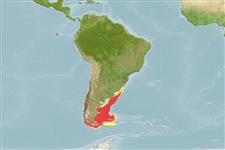分類 / Names
俗名 | 同種異名 | Catalog of Fishes(屬, 種) | ITIS | CoL | WoRMS | Cloffa
Elasmobranchii
板鰓亞綱 (鯊魚與魟魚) (sharks and rays) >
Rajiformes (Skates and rays)
鰩目 (Skates and rays) >
Rajidae (Skates)
鰩科 (Skates)
Etymology: More on author: Guichenot.
Environment: milieu / climate zone / depth range / distribution range
生態學
海洋 居於水底的; 深度上下限 ? - 40 m (Ref. 120403). 溫帶; 4°C - 19°C (Ref. 104541); 18°S - 57°S, 75°W - 52°W
Southeast Pacific: central Chile to the Strait of Magellan.
東南太平洋與西南大西洋: 烏拉圭 (參考文獻 58839) 與智利到巴塔哥尼亞-福克蘭的區域。 來自厄瓜多的紀錄是可疑的。
Length at first maturity / 大小 / 重量 / 年齡
Maturity: Lm 103.5, range 94 - 100 cm
Max length : 152 cm TL 雄魚/尚未辨別雌雄; (Ref. 120403)
簡短描述
型態特徵 | 形態測量圖
This medium-sized speies of Dipturus (up to at least 118.0 cm TL) is distinguished from its congeners by the following set of characters: when fresh, the dorsal surface of body is plain brownish to greyish, with some lighter small spots randomly distributed dorsally; one red to purple ocellus over center of each pectoral fin; ocelli with well-defined margins, irregular in shape, but often indistinguishable in fixed specimens; ventrally, white to grey with lighter patches over area of gill openings and beneath mouth; area flanking rostral cartilage membranous and slightly translucent and opaque and yellowish when fixed. Further differs by having a relatively broad disc with angular apices, its width 76.4 (75.0; 77.0) % TL; snout relatively short and broad; tail longer in males (42.2 [40.8] % TL) than in female voucher ([38.8] % TL); ventral head length 35.1 (34.2; 37.7) % TL; preorbital snout length 2.4 (2.9; 2.9) times distance between orbits; orbit diameter 0.5 (0.5; 0.6) of inter-orbital width; in males, the dorsal surface of disc and tail with central longitudinal band of dermal denticles extending from anterior margin of rostral cartilage to tail, including anterior margins of dorsal and caudal fins; a thin band of dermal denticles at anterior margins of pectoral fins, extending from anterior fontanelle to front line of alar thorn patches; dorsal surface of disc and tail of females covered with small dermal denticles, except for external margins of pectoral fins, pelvic fins, and area surrounding caudo-central thorns; with orbital thorns; a single nuchal thorn is often absent; both sexes without scapular thorns; a patch of malar thorns only in adult males; alar thorns only in adult males; medial-dorsal and lateral-dorsal thorns may be present in large specimens, especially in large females; small central-caudal thorns mostly arranged in longitudinal pairs in males and females, with two additional longitudinal rows of fine, sharp and posteriorly oriented lateral-caudal thorns may be present in large specimens; ventral sensory pores are small, distinct, black-edged, most abundant on snout and around mouth, scattered over area between gill openings, sparsely spaced on abdominal area and pectoral fins (Ref. 120403).
Oviparous (Ref. 50449). Reported size at hatching and incubation period 17.2 cm TL and 252 days, respectively (Ref. 120403). Eggs have horn-like projections on the shell (Ref. 205). Inhabits sandy and muddy bottoms at depths (Ref. 104541).
卵生的.(參考文獻 50449) 卵在貝殼上有像觸角一樣的突出。 (參考文獻 205) 最大體長 (強尼 Labbe , pers. comm。,2000)。
Life cycle and mating behavior
成熟度 | 繁殖 | 產卵場 | 卵 | 孕卵數 | 仔魚
Oviparous, paired eggs are laid. Embryos feed solely on yolk (Ref. 50449). Eggs have horn-like projections on the shell (Ref. 205).東南太平洋與西南大西洋: 烏拉圭 (參考文獻 58839) 與智利到巴塔哥尼亞-福克蘭的區域。 來自厄瓜多的紀錄是可疑的。
Concha, F.J., J. Caira, D.A. Ebert and J.H.W. Pomperi, 2019. Redescription and taxonomic status of Dipturus chilensis (Guichenot, 1848), and description of Dipturus lamillai sp. nov. (Rajiformes: Rajidae), a new species of long-snout skate from the Falkland Islands. Zootaxa 4590(5):501-524. (Ref. 120403)
IUCN 瀕危狀態 (Ref. 130435)
瀕危 (EN) (A2bd); Date assessed: 06 February 2019
人類使用
更多資訊
合作者照片Stamps, Coins Misc.聲音神經毒速度泳型鰓區Otoliths腦重體重比眼睛色素
工具
特別的報告
下載 XML
網路資源
Estimates based on models
Preferred temperature (Ref.
123201): 4.5 - 10.6, mean 6.7 °C (based on 334 cells).
Phylogenetic diversity index (Ref.
82804): PD
50 = 0.6250 [Uniqueness, from 0.5 = low to 2.0 = high].
Bayesian length-weight: a=0.00282 (0.00133 - 0.00596), b=3.25 (3.08 - 3.42), in cm total length, based on LWR estimates for this Genus-body shape (Ref.
93245).
營養階層 (Ref.
69278): 4.5 ±0.6 se; based on diet studies.
Generation time: 9.5 (8.1 - 12.6) years. Estimated as median ln(3)/K based on 13
growth studies.
回復力 (Ref.
120179): 低的, 最小族群倍增時間4.5 - 14 年 (Fec assumed to be <100).
Fishing Vulnerability (Ref.
59153): Very high vulnerability (90 of 100).
Nutrients (Ref.
124155): Calcium = 3.18 [0.45, 55.95] mg/100g; Iron = 0.198 [0.018, 2.222] mg/100g; Protein = 15.2 [12.7, 18.3] %; Omega3 = 0.698 [0.304, 1.673] g/100g; Selenium = 18.6 [3.7, 89.1] μg/100g; VitaminA = 4.17 [0.30, 53.72] μg/100g; Zinc = 0.25 [0.02, 2.75] mg/100g (wet weight); based on
nutrient studies. 